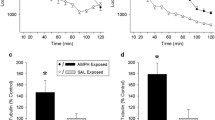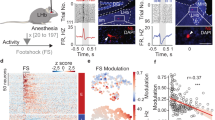Abstract
Existing work on drug-induced synaptic changes has shown that the expression of perineuronal nets (PNNs) at the cerebellar cortex can be regulated by cocaine-related memory. However, these studies on animals have mostly relied on limited manually-driven procedures, and lack some more rigorous statistical approaches and more automated techniques. In this work, established methods from computer vision and machine learning are considered to build stronger evidence of those previous findings. To that end, an image descriptor is designed to characterize PNNs images; unsupervised learning (clustering) is used to automatically find distinctive patterns of PNNs; and supervised learning (classification) is adopted for predicting the experiment group of the mice from their PNN images. Experts in neurobiology, who were not aware of the underlying computational procedures, were asked to describe the patterns emerging from the automatically found clusters, and their descriptions were found to align surprisingly well with the two types of PNN images revealed from previous studies, namely strong and weak PNNs. Furthermore, when the set of PNN images corresponding to every mice in the saline (control) group and the conditioned (experimental) group were characterized using a bag-of-words representation, and subject to supervised learning (saline vs conditioned mice), the high classification results suggest the ability of the proposed representation and procedures in recognizing these groups. Therefore, despite the limited size of the dataset (1,032 PNN images of 6 saline and 6 conditioned mice), the results support existing evidence on the drug-related brain plasticity, while providing higher objectivity.








Similar content being viewed by others

References
Armano, S., Rossi, P., Taglietti, V., D’Angelo, E. (2000). Long-term potentiation of intrinsic excitability at the mossy fiber-granule cell synapse of rat cerebellum. Journal of Neuroscience, 20(14), 5208–5216.
Blacktop, J. M., Todd, R. P., Sorg, B. A. (2017). Role of perineuronal nets in the anterior dorsal lateral hypothalamic area in the acquisition of cocaine-induced conditioned place preference and self-administration. Neuropharmacology, 118, 124–136.
Brückner, G., Brauer, K., Härtig, W., Wolff, J. R., Rickmann, M. J., Derouiche, A., Delpech, B., Girard, N., Oertel, W. H., Reichenbach, A. (1993). Perineuronal nets provide a polyanionic, glia-associated form of microenvironment around certain neurons in many parts of the rat brain. Glia, 8(3), 183–200.
Carbo-Gas, M., Vazquez-Sanroman, D., Aguirre-Manzo, L., Coria-Avila, G. A., Manzo, J., Sanchis-Segura, C., Miquel, M. (2014a). sInvolving the cerebellum in cocaine-induced memory: pattern of cFos expression in mice trained to acquire conditioned preference for cocaine. Addiction Biology, 19(1), 61–76.
Carbo-Gas, M., Vazquez-Sanroman, D., Gil-Miravet, I., De las Heras-Chanes, J., Coria-Avila, G. A., Manzo, J., Sanchis-Segura, C., Miquel, M. (2014b). Cerebellar hallmarks of conditioned preference for cocaine. Physiology & Behavior, 132, 24–35.
Carbo-Gas, M., Moreno-Rius, J., Guarque-Chabrera, J., Vazquez-Sanroman, D., Gil-Miravet, I., Carulli, D., Hoebeek, F., Zeeuw, Chris D., Sanchis-Segura, C., Miquel, M. (2017). Cerebellar perineuronal nets in cocaine-induced pavlovian memory: site matters. Neuropharmacology, 125, 166–180.
Carta, M., Mameli, M., Valenzuela, C. F. (2004). Alcohol enhances GABAergic transmission to cerebellar granule cells via an increase in Golgi cell excitability. The Journal of Neuroscience 24(15), 3746–3751.
Carulli, D., Laabs, T., Geller, H. M., Fawcett, J. W. (2005). Chondroitin sulfate proteoglycans in neural development and regeneration. Current Opinion in Neurobiology, 15(1), 116–120.
Carulli, D., Rhodes, K. E., Brown, D. J., Bonnert, T. P., Pollack, S. J., Oliver, K., Strata, P., Fawcett, J. W. (2006). Composition of perineuronal nets in the adult rat cerebellum and the cellular origin of their components. The Journal of Comparative Neurology, 494(4), 559–577.
Carulli, D., Foscarin, S., Faralli, A., Pajaj, E., Rossi, F. (2013). Modulation of semaphorin3A in perineuronal nets during structural plasticity in the adult cerebellum. Molecular and Cellular Neuroscience, 57, 10–22.
D’Angelo, E., & De Zeeuw, C. I. (2009). Timing and plasticity in the cerebellum: focus on the granular layer. Trends in Neurosciences, 32(1), 30–40.
Foscarin, S., Ponchione, D., Pajaj, E., Leto, K., Gawlak, M., Wilczynski, G. M., Rossi, F., Carulli, D. (2011). Experience-dependent plasticity and modulation of growth regulatory molecules at central synapses. PLOS ONE, 01(1), 1–14.
Frischknecht, R., Heine, M., Perrais, D., Seidenbecher, C. I., Choquet, D., Gundelfinger, E. D. (2009). Brain extracellular matrix affects AMPA receptor lateral mobility and short-term synaptic plasticity. Nature Neuroscience, 12(7), 897–904.
Ghani, M. U., Mesadi, F., Kankık, S. D., Argunşah, A. O, Hobbiss, A. F., Israely, I., Ünay, D., Taşdizen, T., Çetin, M. (2017). Dendritic spine classification using shape and appearance features based on two-photon microscopy. Journal of Neuroscience Methods, 279, 13–21.
Gillette, T. A., Brown, K. M., Ascoli, G. A. (2011). The DIADEM metric: comparing multiple reconstructions of the same neuron. Neuroinformatics, 9(2), 233.
Grigorescu, S. E., Petkov, N., Kruizinga, P. (2002). Comparison of texture features based on Gabor filters. IEEE Transactions on Image Processing, 11(10), 1160–1167. ISSN 1057-7149. https://doi.org/10.1109/TIP.2002.804262.
Grimpe, B., & Silver, J. (2002). The extracellular matrix in axon regeneration. Progress in Brain Research, 137, 333–349.
Hyman, S. E., Malenka, R. C., Nestler, E. J. (2006). Neural mechanisms of addiction: the role of reward-related learning and memory. Annual Review of Neuroscience, 29, 565–598.
Härtig, W., Brauer, K., Brückner, G. (1992). Wisteria floribunda agglutinin-labelled nets surround parvalbumin-containing neurons. Neuroreport, 3(10), 869–872.
Jain, A. K. (2010). Data clustering: 50 years beyond k-means. Pattern Recognition Letters, 31(8), 651–666.
Lazebnik, S., Schmid, C., Ponce, J. (2006). Beyond bags of features: spatial pyramid matching for recognizing natural scene categories. In IEEE conference on computer vision and pattern recognition.
Liu, C., Yuen, J., flow, A. Torralba. SIFT. (2011). Dense correspondence across scenes and its applications. IEEE Transactions on Pattern Analysis and Machine Intelligence, 33(5), 978–994.
Lowe, D. G. (2004). Distinctive image features from scale-invariant keypoints. International Journal of Computer Vision, 60(2), 91–110.
Mikolajczyk, K., & Schmid, C. (2005). A performance evaluation of local descriptors. IEEE Transactions on Pattern Analysis and Machine Intelligence, 27(10), 1615–1630.
Moreno-Rius, J., & Miquel, M. (2017). The cerebellum in drug craving. Drug and Alcohol Dependence, 173, 151–158.
Moulton, E. A., Elman, I., Becerra, L. R., Goldstein, R. Z., Borsook, D. (2014). The cerebellum and addiction: insights gained from neuroimaging research. Addict Biology, 19(3), 317–331.
Niebles, J. C., & Li, F.-F. (2007). A hierarchical model of shape and appearance for human action classification. In IEEE conference on computer vision and pattern recognition.
Pedregosa, F., Varoquaux, G., Gramfort, A., Michel, V., Thirion, B., Grisel, O., Blondel, M., Prettenhofer, P., Weiss, R., Dubourg, V., Vanderplas, J., Passos, A., Cournapeau, D., Brucher, M., Perrot, M., Duchesnay, E. (2011). Scikit-learn: machine learning in Python. Journal of Machine Learning Research, 12, 2825–2830.
Santamaría-Pang, A., Hernandez-Herrera, P., Papadakis, M., Saggau, P., Kakadiaris, I. A. (2015). Automatic morphological reconstruction of neurons from multiphoton and confocal microscopy images using 3D tubular models. Neuroinformatics, 13(3), 297–320. ISSN 1559-0089.
Scott, D. W. (1992). Multivariate density estimation: theory, practice, and visualization. New York: Wiley.
Scovanner, P., Ali, S., Shah, M. (2007). A 3-dimensional SIFT descriptor and its application to action recognition. In Proceedings of the 15th ACM international conference on multimedia (pp. 357–360). New York.
Shaham, Y., Shalev, U., Lu, L., de Wit, H., Stewart, J. (2003). The reinstatement model of drug relapse: history, methodology and major findings. Psychopharmacology, 168(1–2), 3–20.
Slaker, M., Churchill, L., Todd, R. P., Blacktop, J. M., Zuloaga, D. G., Raber, J., Darling, R. A., Brown, T. E., Sorg, B. A. (2015). Removal of perineuronal nets in the medial prefrontal cortex impairs the acquisition and reconsolidation of a cocaine-induced conditioned place preference memory. The Journal of Neuroscience, 35(10), 4190–4202.
Slaker, M. L., Harkness, J. H., Sorg, B. A. (2016). A standardized and automated method of perineuronal net analysis using Wisteria floribunda agglutinin staining intensity. IBRO Rep, 1, 54–60.
Sorg, B. A., Berretta, S., Blacktop, J. M., Fawcett, J. W., Kitagawa, H., Kwok, J. C., Miquel, M. (2016). Casting a wide net: role of perineuronal nets in neural plasticity. The Journal of Neuroscience, 36(45), 11459–11468.
Toyama, B. H., & Hetzer, M. W. (2013). Protein homeostasis: live long, won’t prosper. Nature Reviews Molecular Cell Biology, 14(1), 55–61.
Tuytelaars, T., & Mikolajczyk, K. (2008). Local invariant feature detectors: a survey. Foundations and Trends in Computer Graphics and Vision, 3(3), 177–280.
Van den Oever, M. C., Lubbers, B. R., Goriounova, N. A., Li, K. W., Van der Schors, R. C., Loos, M., Riga, D., Wiskerke, J., Binnekade, R., Stegeman, M., Schoffelmeer, A. N., Mansvelder, H. D., Smit, A. B., De Vries, T. J., Spijker, S. (2010). Extracellular matrix plasticity and GABAergic inhibition of prefrontal cortex pyramidal cells facilitates relapse to heroin seeking. Neuropsychopharmacology, 35(10), 2120–2133.
van der Maaten, L. (2018). t-SNE https://lvdmaaten.github.io/tsne, Last accessed: July 2018.
van der Maaten, L. J. P., & Hinton, G. E. (2008). Visualizing high-dimensional data using t-SNE. Journal of Machine Learning Research, 9, 2579–2605.
van der Walt, S., Schönberger, J. L., Nunez-Iglesias, J., Boulogne, F., Warner, J. D., Yager, N., Gouillart, E., Yu, T., Scikit-image contributors. (2014). scikit-image: image processing in Python. PeerJ, 2, e453, 6. ISSN 2167-8359. https://doi.org/10.7717/peerj.453.
Vapnik, V. N. (1998). Statistical Learning Theory. New York: Wiley,.
Vazquez-Sanroman, D., Carbo-Gas, M., Leto, K., Cerezo-Garcia, M., Gil-Miravet, I., Sanchis-Segura, C., Carulli, D., Rossi, F., Miquel, M. (2015a). Cocaine-induced plasticity in the cerebellum of sensitised mice. Psychopharmacology (Berl.), 232(24), 4455–4467.
Vazquez-Sanroman, D., Leto, K., Cerezo-Garcia, M., Carbo-Gas, M., Sanchis-Segura, C., Carulli, D., Rossi, F., Miquel, M. (2015b). The cerebellum on cocaine: plasticity and metaplasticity. Addiction Biology, 20(5), 941–955.
Vazquez-Sanroman, D. B., Monje, R. D., Bardo, M. T. (2017). Nicotine self-administration remodels perineuronal nets in ventral tegmental area and orbitofrontal cortex in adult male rats. Addiction biology, 22(6), 1743–1755.
Vedaldi, A., & Fulkerson, B. (2008). VLFeat: an open and portable library of computer vision algorithms. http://www.vlfeat.org/.
Vinukonda, P. (2011). A study of the scale-invariant feature transform on a parallel pipeline. Master’s thesis, Department of Electrical and Computer Engineering, Louisiana State University. https://digitalcommons.lsu.edu/cgi/viewcontent.cgi?article=3720&context=gradschool_theses, Last access: July 2018.
Wan, Y., Long, F., Qu, L., Xiao, H., Hawrylycz, M., Myers, E. W., Peng, H. (2015). BlastNeuron for automated comparison, retrieval and clustering of 3D neuron morphologies. Neuroinformatics, 13(4), 487–499.
Wright, J. W., & Harding, J. W. (2009). Contributions of matrix metalloproteinases to neural plasticity, habituation, associative learning and drug addiction. Neural Plasticity, 2009, 579382.
Xue, Y. X., Xue, L. F., Liu, J. F., He, J., Deng, J. H., Sun, S. C., Han, H. B., Luo, Y. X., Xu, L. Z., Wu, P., Lu, L. (2014). Depletion of perineuronal nets in the amygdala to enhance the erasure of drug memories. The Journal of Neuroscience, 34(19), 6647–6658.
Yu, J., Qin, Z., Wan, T., Zhang, X. (2013). Feature integration analysis of bag-of-features model for image retrieval. Neurocomputing, 120, 355–364.
Zhang, D., Liu, S., Song, Y., Feng, D., Peng, H., Cai, W. (2018). Automated 3D soma segmentation with morphological surface evolution for neuron reconstruction. Neuroinformatics 16(2):153-166.
Zhao, W. L., & Ngo, C. W. (2013). Flip-invariant SIFT for copy and object detection. IEEE Transactions on Image Processing, 22(3), 980–991.
Acknowledgments
This work is partly funded by Universitat Jaume I (P1.1B2014-09), by Ministerio de Economía y Competitividad through Plan Nacional de I+D (PSI2015-68600-P), grant FPU12/04059 from Ministerio de Educación, Cultura y Deporte, and grant PREDOC2014/11 from Universitat Jaume I.
Author information
Authors and Affiliations
Corresponding author
Ethics declarations
Conflict of interest
None
Rights and permissions
About this article
Cite this article
Traver, V.J., Pla, F., Miquel, M. et al. Cocaine-Induced Preference Conditioning: a Machine Vision Perspective. Neuroinform 17, 343–359 (2019). https://doi.org/10.1007/s12021-018-9401-1
Published:
Issue Date:
DOI: https://doi.org/10.1007/s12021-018-9401-1



